08-19-2017, 04:36 PM
After adding the support post described previously, parting became totally free of drama and deep DOC’s when turning or facing became commonplace using sharp HSS tools. This is the 8 inch Emco-Maeir taking a .250 DOC at .007 IPR without cutting fluid, reducing a one inch diameter steel shaft to ½ inch in one pass - no chattering, nice finish:
 cut250.jpg (Size: 18.31 KB / Downloads: 125)
cut250.jpg (Size: 18.31 KB / Downloads: 125)
This improvement, although intended for the four-way tool post, might suggest improvements to other cutting tool systems, possibly even the QCTP.
At the risk of causing controversy, it is my personal opinion that the most common QC tool systems used by hobbyists, although convenient, are not a particularly sturdy method of holding cutting tools.
Having said that, generally hobbyists are not particularly concerned with removing a lot of material quickly. After all, the faster metal is removed, the faster the fun is done
The Aloris-Dorian-style system was designed for production usage and reasonable cutting loads, the type of tasks that most of us will never be required to perform. If removing truly massive amounts of metal in an industrial environment (e.g. my previous comment about Westinghouse Marine Division), one will not find either a QCTP or a four-way, although the tool room lathes are almost certain to have them.
I'm going to diverge momentarily for entertainment purposes - machine tool porn. One of the many styles of large lathes that were typical at Westinghouse is shown below. It’s difficult to discern but if you look closely near the headstock end, you will see the lathe operator standing on the carriage !
I seem to recall a couple of these large lathes with TWO carriages and seats mounted on each. A machinist was seated on each traveling carriage, monitoring the operation and making adjustments. The tailstock dead center had to be re-adjusted often to accommodate thermal expansion of the workpiece.
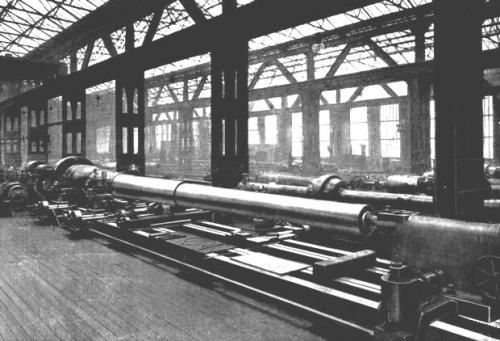
In days of yore, most intermediate-size American lathes were equipped with a lantern/rocker tool post and the Armstrong (or American) system of cutting tool holders. Four way tool posts were preferred by our British cousins by this time although many large four ways had a rocker for adjusting cutting tool height, just like the lantern.

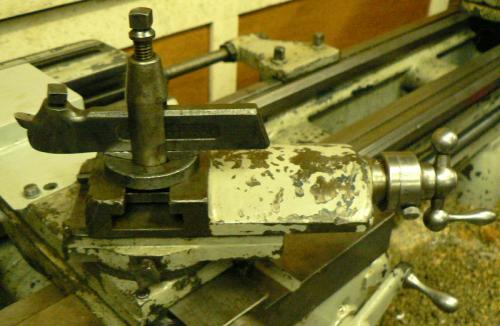
For the hobbyist, there are many advantages to the Armstrong system:
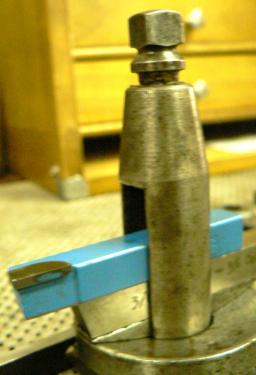

Any operation that can be performed with a QCTP system can be performed with the above method, with more rigidity. In fact, the complete Armstrong tool system can sometimes be more rigid than a QCTP when it is adjusted properly (cutting tool located as close to the lantern as possible)
Perhaps a minor disadvantage of both the QCTP and the four way tool posts is the inability to turn small diameter balls or small radius convex/concave shapes. In the past, cranks, knobs, levers and so forth were gracefully shaped, in the manner of wooden colonial table legs, for example.
These shapes were quite easily turned by adjusting the compound slide appropriately, loosening the compound locking bolts, locking the carriage and slowly rotating the compound by hand. These are a few parts that I made using this technique:
Jeweler’s chasing hammer
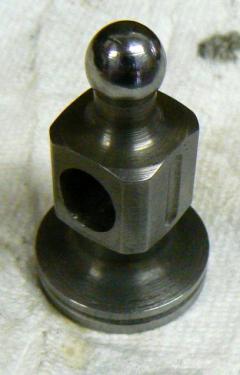
Crank handle
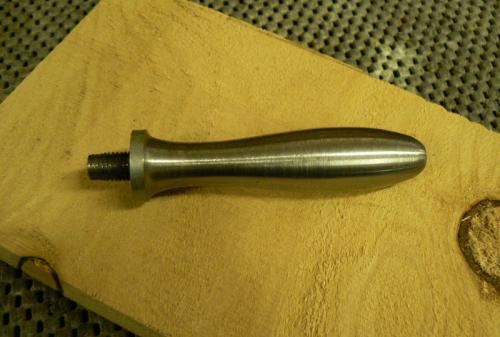
Ball turning
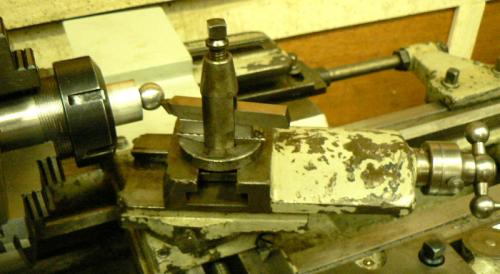
The ability to turn small radii requires that the cutting tool be adjusted very close to the rotation axis of the compound rest pivot point. The configurations of both QCTP and four way tool holders preclude this – the cutting tool is too far from the pivot point of the compound rest. The smallest convex or concave shape these tool holders can produce is on the order of a two or three inch radius.
I suppose that this is the reason ball-turning projects are so popular on hobby forums. It’s possible that most hobbyists haven’t even considered using the compound rest for this purpose.
In fact, I wonder what percentage of commercial shops even have a lantern/rocker tool post, ha-ha-ha - ? But then, how many radii need to be turned on an engine lathe, it’s not exactly a routine operation, right ?
These are just meandering thoughts about a topic that may deserve more attention. Those with experience will know all of this but perhaps some information can be helpful to those learning the craft. As previously noted, one can take the position that hobbyists do not need to be concerned about the efficiency (time savings) of turning operations. That is certainly true so this can be treated as light entertainment :o)
However, here's something worth thinking about: what's not to like about having a lantern, rocker and a few Armstrong holders (especially the bent ones, both right and left) for that rare occasion when they solve the unsolvable problem ? It's not like this stuff is expensive, probably way less than the typical Chinese-made QCTP and sme holders.
These thoughts are not particularly comprehensive or even orderly – just things that have occurred to me when I started writing about improving my four way tool post.
It would be interesting if others added their own ideas/experiences. For example, I read somewhere, sometime, that a long boring tool might be partly supported by a machinist’s jack. I actually used the idea once and benefited from it !
 cut250.jpg (Size: 18.31 KB / Downloads: 125)
cut250.jpg (Size: 18.31 KB / Downloads: 125)
This improvement, although intended for the four-way tool post, might suggest improvements to other cutting tool systems, possibly even the QCTP.
At the risk of causing controversy, it is my personal opinion that the most common QC tool systems used by hobbyists, although convenient, are not a particularly sturdy method of holding cutting tools.
Having said that, generally hobbyists are not particularly concerned with removing a lot of material quickly. After all, the faster metal is removed, the faster the fun is done

The Aloris-Dorian-style system was designed for production usage and reasonable cutting loads, the type of tasks that most of us will never be required to perform. If removing truly massive amounts of metal in an industrial environment (e.g. my previous comment about Westinghouse Marine Division), one will not find either a QCTP or a four-way, although the tool room lathes are almost certain to have them.
I'm going to diverge momentarily for entertainment purposes - machine tool porn. One of the many styles of large lathes that were typical at Westinghouse is shown below. It’s difficult to discern but if you look closely near the headstock end, you will see the lathe operator standing on the carriage !
I seem to recall a couple of these large lathes with TWO carriages and seats mounted on each. A machinist was seated on each traveling carriage, monitoring the operation and making adjustments. The tailstock dead center had to be re-adjusted often to accommodate thermal expansion of the workpiece.
In days of yore, most intermediate-size American lathes were equipped with a lantern/rocker tool post and the Armstrong (or American) system of cutting tool holders. Four way tool posts were preferred by our British cousins by this time although many large four ways had a rocker for adjusting cutting tool height, just like the lantern.
For the hobbyist, there are many advantages to the Armstrong system:
- Small cutting tools are easily held – small HSS tools are inexpensive and, more importantly, much easier and faster to sharpen.
- There is an Armstrong tool holder for just about any situation
- Tools usually can be sharpened while secured in the holder (no burnt fingers)
- Simple and quick to orient the tool and set it on center
- Top rake doesn’t have to be ground on the tool, as it may on QC and four way cutting tools; the Armstrong holders are angled to the approximate required top rake.
- Above all, the system is very universal
- Inexperienced operators may have trouble grinding and adjusting the tool properly
- Probably the least rigid of any system in common use in many setups (note the tool overhang in above photo of the Armstrong tool holder)
- Unsuitable for production rates where multiple operations must be performed on a single workpiece, e.g. turning, threading, facing
Any operation that can be performed with a QCTP system can be performed with the above method, with more rigidity. In fact, the complete Armstrong tool system can sometimes be more rigid than a QCTP when it is adjusted properly (cutting tool located as close to the lantern as possible)
Perhaps a minor disadvantage of both the QCTP and the four way tool posts is the inability to turn small diameter balls or small radius convex/concave shapes. In the past, cranks, knobs, levers and so forth were gracefully shaped, in the manner of wooden colonial table legs, for example.
These shapes were quite easily turned by adjusting the compound slide appropriately, loosening the compound locking bolts, locking the carriage and slowly rotating the compound by hand. These are a few parts that I made using this technique:
Jeweler’s chasing hammer
Crank handle
Ball turning
The ability to turn small radii requires that the cutting tool be adjusted very close to the rotation axis of the compound rest pivot point. The configurations of both QCTP and four way tool holders preclude this – the cutting tool is too far from the pivot point of the compound rest. The smallest convex or concave shape these tool holders can produce is on the order of a two or three inch radius.
I suppose that this is the reason ball-turning projects are so popular on hobby forums. It’s possible that most hobbyists haven’t even considered using the compound rest for this purpose.
In fact, I wonder what percentage of commercial shops even have a lantern/rocker tool post, ha-ha-ha - ? But then, how many radii need to be turned on an engine lathe, it’s not exactly a routine operation, right ?
These are just meandering thoughts about a topic that may deserve more attention. Those with experience will know all of this but perhaps some information can be helpful to those learning the craft. As previously noted, one can take the position that hobbyists do not need to be concerned about the efficiency (time savings) of turning operations. That is certainly true so this can be treated as light entertainment :o)
However, here's something worth thinking about: what's not to like about having a lantern, rocker and a few Armstrong holders (especially the bent ones, both right and left) for that rare occasion when they solve the unsolvable problem ? It's not like this stuff is expensive, probably way less than the typical Chinese-made QCTP and sme holders.
These thoughts are not particularly comprehensive or even orderly – just things that have occurred to me when I started writing about improving my four way tool post.
It would be interesting if others added their own ideas/experiences. For example, I read somewhere, sometime, that a long boring tool might be partly supported by a machinist’s jack. I actually used the idea once and benefited from it !




